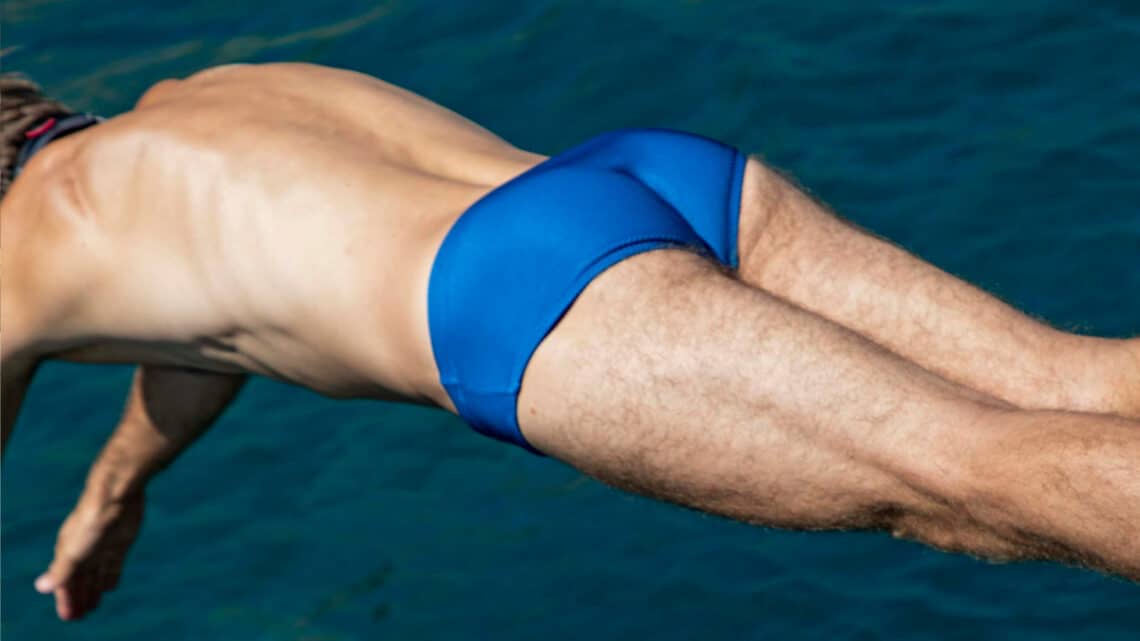
France’s swimming trunks law: Why men have to swim in speedos — and what swimming rules apply in other countries
If you enter a public pool in France, you will soon realize: Different bathing rules apply here than elsewhere. Long, loose swim shorts — which are completely normal in other countries — are strictly forbidden there. Instead, only one thing is allowed for men: tight-fitting swimming trunks, often known as “Speedo”. What at first glance seems like a bizarre style requirement has surprisingly profound reasons — and France is by no means the only country to regulate its swimwear.
Why only tight swimming trunks are allowed in France
The law prohibiting men from wearing wide swim shorts in public swimming pools, campsites, hotel pools or water parks dates back to 1903: and it is still in force. But why this focus on body-hugging swimwear?
1. Hygiene first
The main reason for this is hygiene. Wide swim shorts are considered “street wear” in France, as they are typically worn outside the pool — for example when playing volleyball, shopping in the kiosk or relaxing on the lawn. They pick up dust, dirt and bacteria, which then end up in the pool. Tight swimming trunks, on the other hand, are used almost exclusively for swimming and are considered more hygienic.
2. Safety and technology
Safety also plays a role: wide shorts soak up water and drip onto the floor when leaving the pool, increasing the risk of slipping. In addition, fibers can come loose from the fabric, which then pollute the sensitive filter technology of the pools.
3. A dash of environmental awareness
The more water is dragged out of the pool through clothing, the more often it needs to be replaced or filtered. Tight swimming trunks are considered the more environmentally friendly choice here.
Ad
A law with history — and resistance
There have been repeated attempts to soften the strict rules — for example in Grenoble in 2022. However, there was strong resistance: the majority of swimming pool operators consider the law to be important to maintain cleanliness, technology, and the swimming experience for everyone.
Where the regulation applies — and where it does not
Significant to know: The law only applies to public swimming pools, hotel complexes with pools, campsites with water access and water parks. Anyone can wear what they want on the beach, lakes, or rivers.
Ad
Not an isolated case: swimwear laws around the world
France is not alone with its “Speedo law”. In many countries and cities — especially in Europe — there are rules that restrict or prohibit the wearing of swimwear as soon as you move away from beaches or pools. This is often about the cityscape, respect for the local population — or keeping order in tourist-crowded regions.
Spain
In Barcelona, Málaga, and Palma de Mallorca, it is forbidden to walk through the city wearing only a bikini or swimming trunks. Those who do not comply risk fines of up to €250. The aim is to protect the cityscape and curb excessive party tourism (“drunken tourism”).
Italy
In Sorrento or on the island of Lipari, you are not allowed to wear swimwear in the city center. Even topless is sanctioned — with fines of up to €500.
Croatia
In Split, Hvar and Dubrovnik in particular, rules on wearing swimwear outside the beaches are strict — with fines of up to €600. This is also about protecting historical buildings and respecting cultural heritage.
Portugal
In Albufeira in the Algarve, fines of up to €1,500 are now possible if holidaymakers walk through the old town in swimwear. The measure is intended to strengthen the region’s family image.
Australia & USA
Melbourne (Australia) has an old law that requires swimwear that covers the shoulders to the knee. In Melbourne (Florida), wearing thongs on the beach is prohibited. In Washington D.C., on the other hand, there are strict rules in pools — no street clothes, no overly revealing clothing.
Burkini-Debatte
The burkini bans in countries such as France, Belgium, Italy, and Austria are particularly controversial. The justifications range from hygiene and safety concerns to debates about cultural integration — and repeatedly make the headlines.
Ad
What is behind all these regulations?
Whether it’s a speedo ban or a bikini ban in old towns — the motives are usually similar:
- Hygiene and equipment protection: As in France, the pool water should remain clean, and the equipment should not be damaged.
- Safety: Danger of slipping, visibility underwater and materials that can come loose are arguments in many countries.
- Protecting the cityscape: Especially in historic cities, the sight of half-naked tourists should not be part of everyday life.
- Respect for locals: Many people consider skimpy swimwear away from the beach to be disrespectful.
- Tourism management: Cities want to present themselves as family-friendly and culturally aware — not as party meccas.
Conclusion: Well informed is better bathed
Anyone traveling in summer should find out about the local swimming rules in advance — and pack not only sunscreen, but perhaps also a suitable swimsuit or slightly tighter swimming trunks. Because what is considered casual in Germany can raise eyebrows or even result in hefty fines elsewhere.
In France, you can’t jump into the pool without a speedo. If you know this, you’ll save yourself trouble — and enjoy the summer in style, in compliance with the law and with dry feet.
Tip for holidaymakers in France: A classic pair of tight swimming trunks should be in your luggage — preferably made of quick-drying material and with a hygienic lining. That way, you’re on the safe side — whether you’re in the outdoor pool in Marseille or at the water park on the Atlantic coast.
NOTE: THIS ARTICLE IS ALSO AVAILABLE IN German.






